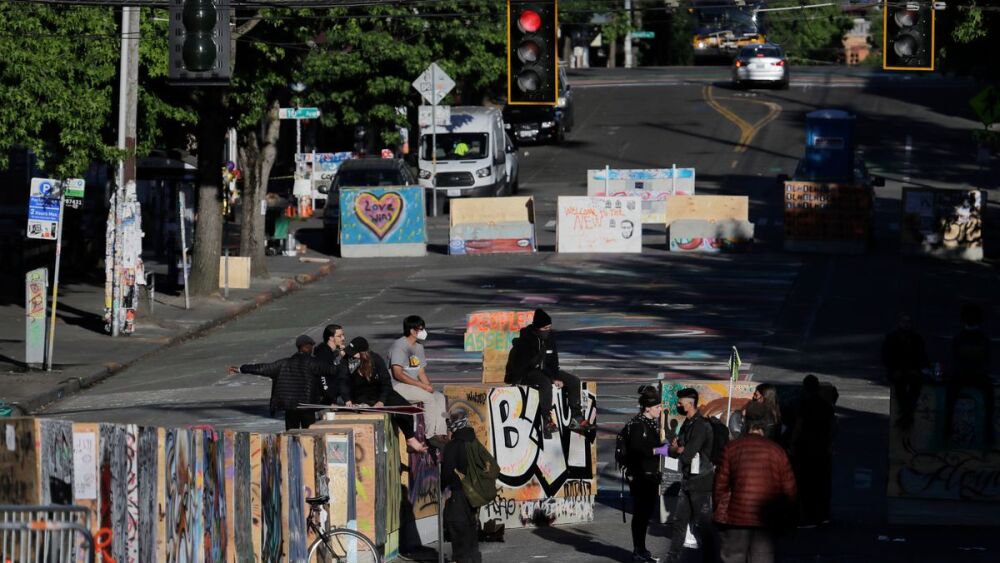Mike Carter
The Seattle Times
SEATTLE — The mother of a 19-year-old Seattle man fatally shot during last summer’s Capitol Hill Organized Protest (CHOP) has filed a federal civil-rights lawsuit against the city, alleging officials were negligent in allowing Seattle police to abandon the department’s East Precinct and surrounding area, a decision that invited “lawlessness and ... a foreseeable danger” that led to his death.
Donnitta Sinclair, whose son Horace Lorenzo Anderson was shot and mortally wounded across the street from Cal Anderson Park early on June 20, alleges in her lawsuit that bad decisions, confusion, miscommunication and poor planning by city officials contributed to his death.
Anderson, who went by his middle name, had graduated from an alternative youth-education program the previous day, and was visiting the CHOP zone when he ran into a rival identified as 18-year-old Marcel Long, according to police. According to surveillance video and witnesses, the two exchanged words and Anderson was walking away when Long, who had been restrained momentarily by others, pulled a handgun and shot him several times, police said.
Long was charged with premeditated first-degree murder, but is believed to have fled the state and remains at large. A spokesman for the Seattle Police Department said Thursday the case remains active.
Sinclair’s lawsuit alleges that Long knew the CHOP was a “no-cop zone.”
After he was shot, a badly wounded Anderson fell to the sidewalk where citizens and volunteer medics manning a nearby first-aid station attempted to treat his wounds. According to the lawsuit, a Seattle Fire Department Medic One ambulance was a block and a half away.
“Video circulating on social media shows a man imploring the medics to help Anderson,” the lawsuit claims. “‘You could be saving his life,’” the lawsuit quotes the video. “‘You could be saving his life right now. Sir, please, explain to me what’s going on. He’s dying. He needs your help.’”
The lawsuit says miscommunication between the agencies over the location of the firefighters “caused a delay of approximately 20 minutes” in responding to the scene. When firefighters eventually arrived at the shooting scene, Sinclair had already been loaded into a pickup by citizens and volunteers and taken to Harborview Medical Center, where he died, the lawsuit alleges.
In the hours after the shooting, the police department said a hostile crowd had prevented officers from reaching Anderson. The fire department said that by policy, when responding to scenes of violence, they had to wait for police to secure the scene. The department released video showing several officers enter the protest zone with guns drawn, as protesters shouted at them to put the weapons away. However, demonstrators said, by that point Anderson had already been taken to the hospital.
The lawsuit argues any crowd hostility toward police stemmed from their failure to respond to the shooting scene.
In a news release announcing the lawsuit, Sinclair, who works with at-risk youth, said she wants answers for her son’s death. “Explain to me why they didn’t go in there and help my son,” Sinclair said.
Sinclair’s lawsuit joins several others filed against the city, including a $3 billion claim filed by Anderson’s father, Horace, and a massive proposed class-action federal lawsuit filed by more than a dozen Capitol Hill businesses and residents who claim the city’s tolerance of the CHOP and decision to pull law enforcement from the area cost them millions and violated their rights to live and operate safely.
The lawsuits all focus on a single decision they attribute to city officials — the sudden abandonment of the SPD’s East Precinct on June 8 and the withdrawal of most police and fire services from a roughly six-square block area centered on the precinct and Cal Anderson Park across the street. Thousands of protesters gathered there, a tent city was erected and during the daytime the event took on a carnival-like atmosphere that included speakers and anti-police and anti-racism protests after the May 25 murder of George Floyd by a Minneapolis police officer.
No city official has acknowledged making the decision to pull troops from the precinct, a move that occurred after several days and nights of raucous and at-times violent protests that saw large crowds surrounding officers and pelting them with water bottles, rocks and fireworks. Police responded with tear gas, pepper-spray and rubber projectiles against violent and nonviolent protesters alike, resulting in a federal injunction against the use of crowd-control weapons on peaceful protesters. Subsequent violations of that injunction led to the department being found in contempt of court.
Sinclair’s lawsuit alleges Mayor Jenny Durkan “spun CHOP as ‘a summer of love’ and ‘block party’ ... implying it was fun and safe” when the reality was that it was the site of two homicides, vandalism, robberies and sexual assaults. No one has been arrested or named as a suspect in the death of the other teenager killed at the CHOP, 16-year-old Antonio Mays Jr.
Dan Nolte, a spokesman for City Attorney Pete Holmes, said the lawsuit is being reviewed and the city will be defended.
___
(c)2021 The Seattle Times


